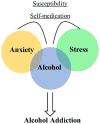Epigenetic mechanisms of alcoholism and stress-related disorders
- PMID: 28477725
- PMCID: PMC5464725
- DOI: 10.1016/j.alcohol.2017.01.001
Epigenetic mechanisms of alcoholism and stress-related disorders
Abstract
Stress-related disorders, such as anxiety, early life stress, and posttraumatic stress disorder appear to be important factors in promoting alcoholism, as alcohol consumption can temporarily attenuate the negative affective symptoms of these disorders. Several molecules involved in signaling pathways may contribute to the neuroadaptation induced during alcohol dependence and stress disorders, and among these, brain-derived neurotrophic factor (BDNF), corticotropin releasing factor (CRF), neuropeptide Y (NPY) and opioid peptides (i.e., nociceptin and dynorphin) are involved in the interaction of stress and alcohol. In fact, alterations in the expression and function of these molecules have been associated with the pathophysiology of stress-related disorders and alcoholism. In recent years, various studies have focused on the epigenetic mechanisms that regulate chromatin architecture, thereby modifying gene expression. Interestingly, epigenetic modifications in specific brain regions have been shown to be associated with the neurobiology of psychiatric disorders, including alcoholism and stress. In particular, the enzymes responsible for chromatin remodeling (i.e., histone deacetylases and methyltransferases, DNA methyltransferases) have been identified as common molecular mechanisms for the interaction of stress and alcohol and have become promising therapeutic targets to treat or prevent alcoholism and associated emotional disorders.
Keywords: Alcohol; Anxiety; DNA methylation; Epigenetic; HDAC; Histone methylation; Stress.
Published by Elsevier Inc.
Conflict of interest statement
SCP reports that a US patent application entitled “Histone acetyltransferase activators and histone deacetylase inhibitors in the treatment of alcoholism” (serial number 60/848237 filed on September 29th, 2006) is currently pending. Other authors reported no biomedical financial interests or potential conflicts of interest.
Figures



Similar articles
-
DNA modifications in models of alcohol use disorders.Alcohol. 2017 May;60:19-30. doi: 10.1016/j.alcohol.2016.11.004. Epub 2016 Nov 9. Alcohol. 2017. PMID: 27865607 Free PMC article. Review.
-
[Epigenetic mechanisms and alcohol use disorders: a potential therapeutic target].Biol Aujourdhui. 2017;211(1):83-91. doi: 10.1051/jbio/2017014. Epub 2017 Jul 6. Biol Aujourdhui. 2017. PMID: 28682229 Review. French.
-
Neuropeptide y: role in emotion and alcohol dependence.CNS Neurol Disord Drug Targets. 2006 Apr;5(2):181-95. doi: 10.2174/187152706776359592. CNS Neurol Disord Drug Targets. 2006. PMID: 16611091 Review.
-
Stress, epigenetics, and alcoholism.Alcohol Res. 2012;34(4):495-505. Alcohol Res. 2012. PMID: 23584115 Free PMC article. Review.
-
The Impact of Alcohol-Induced Epigenetic Modifications in the Treatment of Alcohol use Disorders.Curr Med Chem. 2024;31(36):5837-5855. doi: 10.2174/0109298673256937231004093143. Curr Med Chem. 2024. PMID: 37828672 Review.
Cited by
-
Epigenomic mechanisms of alcohol-induced impaired differentiation of skeletal muscle stem cells; role of Class IIA histone deacetylases.Physiol Genomics. 2019 Sep 1;51(9):471-479. doi: 10.1152/physiolgenomics.00043.2019. Epub 2019 Aug 9. Physiol Genomics. 2019. PMID: 31398085 Free PMC article.
-
Alcohol Feeding in Mice Promotes Colonic Hyperpermeability and Changes in Colonic Organoid Stem Cell Fate.Alcohol Clin Exp Res. 2017 Dec;41(12):2100-2113. doi: 10.1111/acer.13519. Epub 2017 Nov 7. Alcohol Clin Exp Res. 2017. PMID: 28992396 Free PMC article.
-
Transcriptome Analysis of Alcohol Drinking in Non-Dependent and Dependent Mice Following Repeated Cycles of Forced Swim Stress Exposure.Brain Sci. 2020 May 2;10(5):275. doi: 10.3390/brainsci10050275. Brain Sci. 2020. PMID: 32370184 Free PMC article.
-
Brain lncRNA-mRNA co-expression regulatory networks and alcohol use disorder.Genomics. 2024 Sep;116(5):110928. doi: 10.1016/j.ygeno.2024.110928. Epub 2024 Aug 26. Genomics. 2024. PMID: 39197730 Free PMC article.
-
Changes in Alcohol Use after Metabolic and Bariatric Surgery: Predictors and Mechanisms.Curr Psychiatry Rep. 2019 Aug 13;21(9):85. doi: 10.1007/s11920-019-1070-8. Curr Psychiatry Rep. 2019. PMID: 31410716 Free PMC article. Review.
References
-
- Agudelo M, Figueroa G, Parira T, Yndart A, Muñoz K, Atluri V, Samikkannu T, Nair MP. Profile of class I histone deacetylases (HDAC) by human dendritic cells after alcohol consumption and in vitro alcohol treatment and their implication in oxidative stress: role of HDAC inhibitors trichostatin A and mocetinostat. PloS One. 2016;11(6):e0156421. - PMC - PubMed
-
- Baldwin HA, Rassnick S, Rivier J, Koob GF, Britton KT. CRF antagonist reverses the ‘anxiogenic’ response to ethanol withdrawal in the Rat. Psychopharmacology. 1991;103(2):227–32. - PubMed
-
- Baker-Andresen D, Flavelli CR, Li X, Bredy TW. Activation of BDNF signaling prevents the return of fear in female mice. Learning & Memory. 2013;20(5):237–240. - PubMed
Publication types
MeSH terms
Substances
Grants and funding
LinkOut - more resources
Full Text Sources
Other Literature Sources
Medical
Miscellaneous

